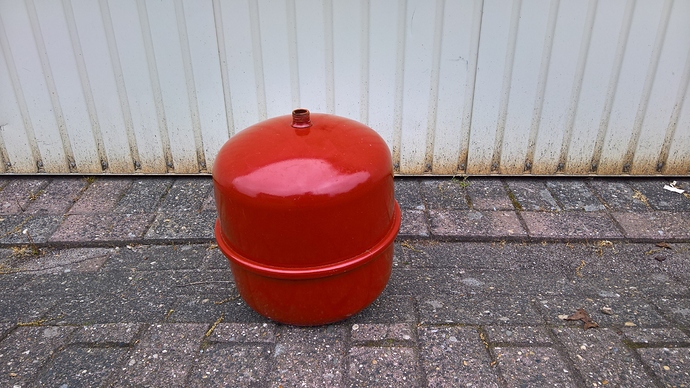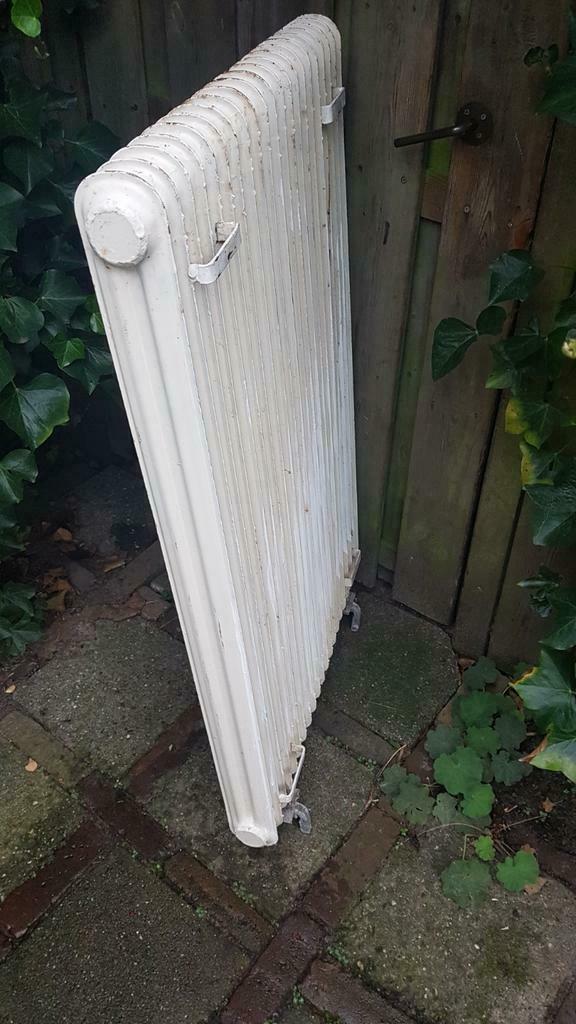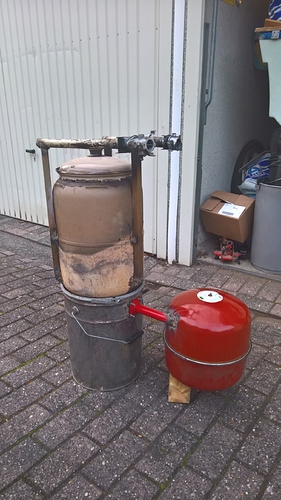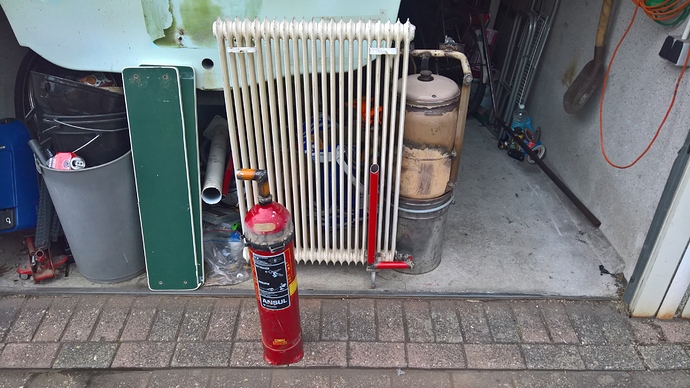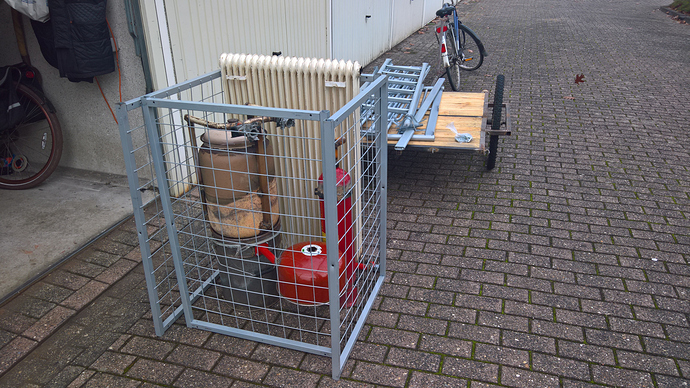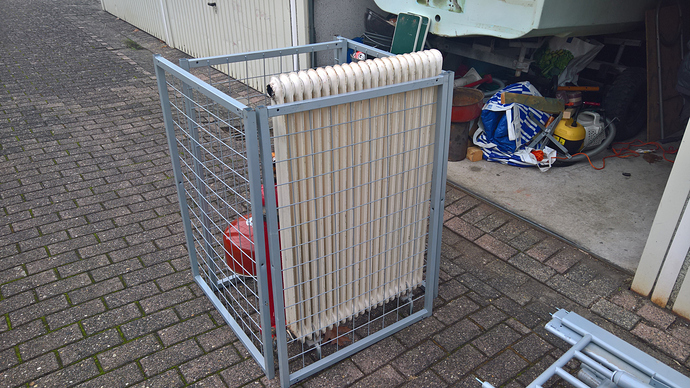Any storing of said gas with as much as 22% hydrogen would likely require a permit, and likelly high teck ox sensors too ensure no oxegen had entered the storage vessel.The energy loss from stored wood gas that seperates seting is high loss, and the hydrogen would seep out of any tiny leaks, as the expence and the wood adds up.The fuel on demand gasifier holds a better value all way around in these departments of wood in and energy out. Futher more wood gas stored in an open empty 100 pound propane tank would not go probly a mile?
Can a propane tank hold that much pressure?
Jahee, I didn’t mean to imply that you should run out and buy new equipment. Just suggesting you would do well to save up for it. And looking at the pictures of your work, I’d also suggest that you look into a career as a welder. I think you have the knack.
First job I had as a welder was at a small shop, 5 people. The owners were nice enough to let me work on some of my projects there. Plus I had access to any scrap I could use. Of course as my projects got bigger and more ambitious, they started charging me. A case of beer any day I wanted to stay late and work on my stuff. 
Bigger shops or factories tend not to be as hospitable.
Maybe. I don’t know. But, just to show that not all gases need oxygen to go boom, google:
“what happens to acetylene above 15 psi”
Not only does it become unstable, but if it is oxygenated it’ll form dihydrogen monoxide! Potentially dangerous stuff.
http://www.dhmo.org/facts.html
My side hurts  . Maybe I shouldn’t have put it in my hot tub.
. Maybe I shouldn’t have put it in my hot tub.
Thank you for the compliment Nathaniel! I have considered becoming a real welder. But in the past I have been blind for a week due to no welding helmet. And I still get easily burned eyes. Even with a propper (electronic) welding helmet. So I like to keep welding as a hobby. And tbh, in the past I have worked in “the steel industry” operating machines. They also had manual welding people, and I know for sure I could do the same stuffs. (it was very easy fab work they did)
Also, I was talking about an LPG tank. From a car. LPG stands for Liquid Petrolium Gas. And it is slightly common in my area/the netherlands. They are rated for about 50-60 bars (without checking google), so 25-30 bars of pressure should not cause any pressure related issues. And yes @ Pete, I will do my research when and if I’ll go and compress the woodgas.
@Kevin, I am considering using it to cook with. It seems that it is comparable to “city gas”?
I will look into all of this stuffs, after I’ve got a functional gasifier to run a small generator.
I did just do a Google search and some math. LPG can liquify between 32 and 320 psi (2.2 to 22 bar) depending on composition. Typical practice is to test pressure vessels at 2 1/2 times their expected load limit (I actually used to do this) as a safety margin. 22 X 2.5 = 55 bar. So I guess you are correct. But I recommend that you respect that safety margin. The vessels corrode and expand and contract through use, and while it may take many fill/empty cycles, that tank is steadily getting weaker, especially if you pressurize it past what it was intended to take, vs what it could handle in a ten minute static test. Also I figure you’ll be scrounging the tanks, so who knows what abuse they might have taken before you you get them. Not trying to discourage you. Just the obligatory caution warning from someone who’s seen pressure vessels fail. If you find tanks in good shape and keep it 20-25 bar it should be fine (excluding oxygen, leaks, or catastrophic chemical decomposition issues).
I think city gas was richer. It was typically made by the destructive distillation of coal. Or by coal and steam as water gas. Wood gas by destructive distillation should have around 2 1/2 times the energy of wood gas from the typical partial combustion gasification process. It’s the nitrogen in the atmosphere that dilutes the fuel gas in the combustion process that reduces it’s energy density.
Another obligatory caution (sorry I know they can seem discouraging). Cooking with it. It contains high levels of carbon monoxide. Carbon monoxide neutralizes the blood’s ability to carry oxygen. Moving to fresh air won’t undo the effects from breathing CO. Keep it outside. Stay up wind of it. I know a couple of guys that suffered CO poisoning, their health hasn’t been the same since. Heart problems, muscle problems, and for one some mental health issues.
Never EVER compress this gas EVER. It can and WILL explode if you get air into the mix. This gas is carrying tars will wreck the seals on your pump and can allow air to get in. Hydrogen will degrade any metal vessel you compress in. This can end very bad, just dont do it. Take it on demand it is less hassel and just as easy. If you really want to store convert it to DC electric power and store it in a battery bank.
I just learned something new. Thanks Matt. I knew hydrogen was a problem when welding. Didn’t realise just it’s presence could damage the metal. I googled it. It most definitely can weaken metal just by being present. Wikipedia, hydrogen damage, for a quick rundown of the ways hydrogen can damage metal.
I’ve read that entire wiki article. I won’t claim I understand it all, but the most interesting thing to me was this: “Steel containment vessels exposed to extremely high hydrogen pressures develop small fissures or micro perforations through which fluids may leak.”
An LPG tank is a steel containment vessel. It does have high pressures, including ones from hydrogen. (I do not consider 25-30 bars extremely high) Worst case the tank will start leaking hydrogen, which could create the risk of an explosion. But I would asume storing it in a well ventilated place, reduces the risk of explosions to acceptable levels. (consider battery powered forklifts which are put on a charger… Those too should be in a spark free and well ventilated room due to a possible build-up of hydrogen)
But AGAIN: I first need to get a functional gasifier, powering an small generator.
Jahee, before you try compressing to such a high pressure remember that Producer gas is “produced” and it’s content is variable and subject to chemical change. When you pressurize it above a few bars portions of it will revert to the CO2, H2O, and C which is its stable state instead of the CO and H and all their complex Hydro carbon combinations. Let alone all the weird acidic water based secondaries that will come out of it. So here is my advice taken from quite a few “go boom” events. If you want an urban friendly approach built with junk, involving cooking and storage look at the charcoal powered units. Break apart the gasification process into heat generation for cooking for charcoal production and engine running for a fun hobby and occasional long runs. My back of the envelope math says the energy required to produce, cool, filter, compress and store the raw wood gasifier gas is greater then the energy consumed in the charcoaling process. The unit you have already made could easily be converted to burn charcoal. Gary Gilmores TLUD inspired charcoal makers and Koen’s charcoal gasifiers are great places to start…
One more thing, Mr Teslonian… There are hundreds of people on this site building and running their units regularly. Have you come across a single one who has told you to Use teslonian’s design? Perhaps there are reasons. Enough said.
Cheers, David
to fix that you either need to get your welding helmet lens adjusted or buy a welding helmet with a solid lens and just close it before you start your weld. the only helmets I use are the $12.99 solid not changing helmets from northern tool, I don’t like automatic darkening hoods.
You’re right Jahee, first step is a working gasifier. So what do you need to make that happen?
Sorry if warnings about compressing the gas is getting frustrating. We’re just concerned about your safety.
You could make charcoal while cooking, then run your generator off the charcoal. Check out Gary’s PA pyramid for an idea. Make a grill rack to go on top. Make charcoal and BBQ at the same time. I do that occasionally. You could use a Weber grill, and scoop the charcoal into a metal container to put it out once it’s done cooking down.
I have used every type of helmet there is over the past 50 years, from cheap ones to $600 Jackson This is hands down the best; accu strike welding helmets chin operated
Good sunny (cold) Pacific Northwest Morning to you, Jahee.
I’ve gone back through my notebooks to fine you at least two advid YouTube broadcasting woodgasifiers who have learned all of the steps well. And try and show/tell teach these.
Mr Teslonian is O.K. But you will find in Life you always want to get at least THREE separate inputs before you would commit/trust.
CNCmachiningisfun on YouTube does an excellent job of it. He is Steven Tetlow down in New Zealand.
Another was docdcox (Danny Cox). Sadly he seems to have pulled and no longer supports his former YouTube broadcasts.
So for a number three try:
engineer775
These three fellows have learned and do understand the actual wood-to-good-engine-gas-steps needed. And they are NOT just YouTube channel subscriber/viewings farming for the YouTube kick back moneys. They will even step up and correct in comments on others video presentations even if it would cause them some YouTube management ire.
You do know this is part of the YouTube suck’em in for profits game, eh? Pay the show-and-tells to sing, dance and show leg and cleavage to suck in the lookie-lou’s for commercials exposures.
And YouTube now owned and controlled by big Google will “reward” YouTube broadcasters with search order preferences for money too. Wanna’ be search/seen top of page more? Pay Google for this.
Regards
Steve Unruh
A few people on this forum have figured out how to store the gas in a solid form that could last a thousand years with no leakage lost. They make charcoal.
Wood is also a zero discharge solar battery, so long as it’s kept dry…
It’s been over a year. But a tiny bit of progress is made.
Expansion vessle from a central heating unit. Will be turning this into a cyclone filter.
Radiator I paid too much for. But it’s heavy as fook, with large intake/exhaust ports. Gas will go in from the top, exit from the bottom.
I was about to pay 10 euros for the left one. After hearing my build project, the seller just gave me this 1958 CO2 fireextinguisher for free. This will be my final “particles” filter.
Got this bed for free. Free metal/resources to play with!
So these are the resource updates.
I welded a bracket to the bucket, so I could bolt on this metal pipe. It’s actually an “IKEA” table/desk leg. This welding was very hard, because this bucket isn’t even 1 mm thick. Will be adding some stone “chalk” to it to make sure it’s airtight. (no obvious holes) The metal pipe is connected to the expansion vessel. No internals of this cyclone filter have been welded up so far.
In this picture, you can see the radiator. It’s currently upside down. This red pipe, will be connected to the top of the cyclone filter. The fire extinguisher has also been modified. I took off the top, and then I welded the 2 black straps onto the top part. One on the outside, one on the inside. This way, I’ve got a V-shape, in which I can put gasket materials. I’ve also welded on some metal tubes on top, which comes from a hand cart I took apart. A vacuüm cleaner hose will fit very snugly onto it. Not visible on the picture, but I’ve also made a hole in the bottom. The radiator will be connected to it there. I’m considering using scrap aluminium (which should act like an catalytic converter), and “sawdust” (the kind you might use in an indoor rabbit enclosure) as filter medium.
Last 2 pictures are a mock-up. This “fence stuffs” is part of that bed. Where the matras should be put onto. Should provide “some” safety, and makes everything look so much more professional.
Went up in this thread and saw the post about the welding helmet recommended by Al. I wish I had the bucks. I’d order one right now. I too have been welding since 1966. Must have flipped a hood up and down a million times. A while back I bought a Harbor Freight auto-darkening hood but after about a year the sensor slowed down so I was getting a bright flash before it went dark. Not enough to hurt but enough so that you had about a long second before you could see your arc. I’m back to flipping a hood up and down now. Still, when it worked right I loved that auto-dark feature.
Tom, You might check the battery voltage in the Harbor Freight hood. I have had some flaky things happen when the voltage is off. You can get batteries that work off the internet.
